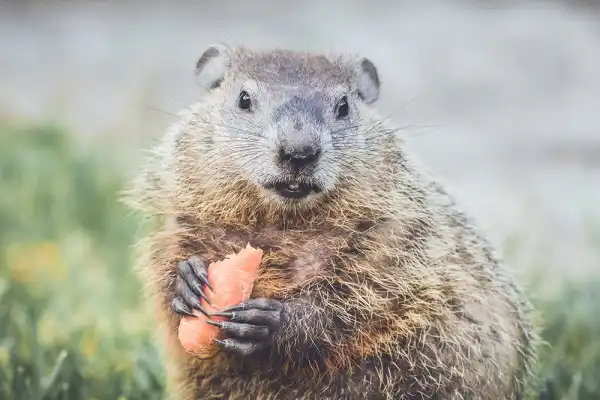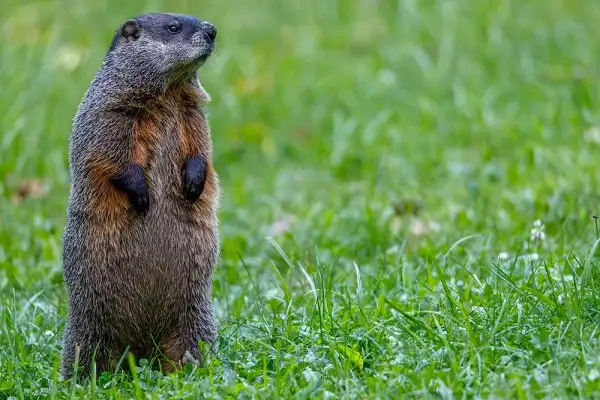Each February, thousands of people tune into the famous groundhog ceremony to find out if spring will come early or late. But what do we actually know about woodchucks? This post will explore the amazing adaptations and habitats of these mammals. From their unique way of hibernating to their diet and predators, you’ll be surprised by all the interesting facts about groundhogs. Plus, get an overview of where these small creatures can be found around the world!

Groundhog Woodchuck Description
Groundhog woodchucks, also known as ground squirrels, are medium-sized rodents that belong to the marmot family. These animals have a robust body. They have sharp, strong claws that help them dig burrows and a short, bushy tail about 4 to 7 inches long. The dense fur of the groundhog woodchuck is typically a reddish-brown color, and it provides excellent insulation during the colder months. Their fur is also waterproof, which helps them stay dry in wet environments. These animals have sharp incisors that never stop growing and are used to forage for food. Groundhog woodchucks are well-known for their ability to stand upright on their hind legs, which allows them to gain a better view of their surroundings when they sense danger.
Groundhog Woodchuck Habitat
Groundhog woodchucks are native to North America and typically inhabit open areas such as fields, meadows, and woodland edges. They are adaptable animals and can live in a variety of habitats as long as there is access to food, water, and appropriate shelter. These mammals are known to be most active during the daytime and spend much of their time underground in complex burrow systems. Their burrows provide protection from predators and harsh weather conditions. They often have multiple entrances and rooms that serve different purposes, such as sleeping, eating, and defecating. The habitat of the groundhog woodchuck can vary depending on its location. In the eastern part of North America, they are found in areas with a relatively high moisture level, such as forests, ravines, and streams. In the western part of North America, they are found in drier prairie habitats. Groundhog woodchucks are well-adapted to a variety of habitats but prefer open areas with access to food, water, and appropriate shelter. They are active during the daytime and spend much of their time in complex burrow systems that provide protection from predators and harsh weather conditions.
Groundhog Woodchuck Diet
Groundhog woodchucks have a primarily herbivorous diet, feeding on a wide variety of vegetation such as grasses, weeds, and clovers. They are also known to consume fruits and vegetables when available, such as apples or squash. In addition to plant-based foods, they will occasionally supplement their diet with insects, snails, and other small animals. Their unique dental anatomy, with ever-growing incisors, allows them to efficiently gnaw on tough vegetation and roots. They have a special ability to grind their food in a unique side-to-side motion that helps them break down tough fibers and extract maximum nutrition from their tough plant-based diet. Interestingly, groundhogs can eat 1/3 of their body weight in a single meal, which is important for building up reserves before winter hibernation. Groundhog woodchucks are selective eaters and will choose the most nutritious parts of plants whenever possible. For example, they prefer to feed on young, tender grass shoots versus older, tougher grasses. They have also been observed actively foraging for specific plants, such as plantain, which is thought to have medicinal qualities that benefit their health.

Groundhog Woodchuck Size
Groundhog woodchucks are medium-sized mammals that belong to the rodent family, weighing between 4 and 14 pounds and measuring up to 27 inches in length, including their short, bushy tail. They have a stocky build with short, powerful legs that are adapted for digging and climbing. Their fur is dense and varies in color from brown to grayish-brown, with a lighter underbelly. Their ears and eyes are located high on their head, providing them with keen senses of hearing and vision. Interestingly, these mammals have a unique adaptation known as “endothermic insulation,” which allows them to regulate their internal body temperature in cold weather conditions. This adaptation involves increasing their metabolism and heart rate, which produces heat and keeps them warm.
Groundhog Woodchuck Lifespan
Groundhog woodchucks have a lifespan of around 6-8 years in the wild, although some individuals have been known to live up to 14 years in captivity. The exact lifespan of a groundhog woodchuck can depend on a variety of factors, including genetics, habitat quality, and environmental conditions. One important factor that can impact the lifespan of groundhog woodchucks is predation. These animals are preyed upon by a variety of predators, including foxes, coyotes, and birds of prey such as hawks and eagles. Groundhog woodchucks have evolved a variety of defensive behaviors to help protect themselves from predators, including the ability to climb trees and quickly retreat to their burrows. Another factor that can impact the lifespan of groundhog woodchucks is a disease. These animals are susceptible to a variety of diseases, including rabies, tularemia, and plague. In some cases, outbreaks of disease can have a significant impact on groundhog woodchuck populations, particularly in areas with large concentrations of animals.
Groundhog Woodchuck Behavior
Groundhog woodchucks are fascinating animals whose behaviors are just as interesting as their physical characteristics. These creatures are primarily active during the day and spend much of their time in their underground burrow systems, where they seek refuge from predators and extreme weather conditions. When not burrowing, groundhog woodchucks can be seen foraging for food in fields, meadows, and other open areas. These animals are herbivorous and have a preference for certain plants such as clover, dandelions, and alfalfa. Interestingly, they have a unique digestive system that allows them to extract and absorb more nutrients from plant material than other herbivores.
Another notable behavior of groundhog woodchucks is their hibernation during the winter months. As the weather becomes colder and food sources become scarce, these animals will retreat to their burrows and enter a state of decreased heart rate and metabolism, conserving energy until the warmer months return. Groundhog woodchucks are also known for their territorial behavior. They will defend their burrows and surrounding areas from other groundhogs, using vocalizations and physical displays such as teeth chattering and posturing. Despite this territorial behavior, groundhog woodchucks are generally solitary animals and will only come together during mating season.

Groundhog Woodchuck Speed
Groundhog woodchucks are not typically known for their speed, as they tend to move at a leisurely pace while foraging for food or searching for new burrows. However, when faced with the threat of a predator, groundhog woodchucks can move surprisingly quickly. These animals are able to run at speeds of up to 8 miles per hour, which may not sound like much, but is actually quite impressive when you consider their short legs and compact build. They are also able to climb trees and navigate rocky terrain with ease, further highlighting their agility and adaptability. One interesting fact about groundhog woodchucks and their speed is that they have been known to predict the coming of spring through their behavior.
Groundhog Woodchuck Hunting
Groundhog woodchucks are fascinating animals known for their unique behaviors and adaptations to survival in the wild. While these creatures are not typically hunted for game, their presence can pose a challenge for farmers and gardeners as they can be destructive to crops and gardens. One of the main challenges of hunting groundhog woodchucks is their elusive nature. These animals are generally solitary and tend to avoid human contact, making it difficult to locate and target them for hunting. Additionally, groundhog woodchucks are known for their speed and agility, making them difficult to catch or trap. Despite the challenges of hunting groundhog woodchucks, there are a number of techniques and strategies that can be employed to increase the chances of success. One common method is to set up bait stations near their burrows or feeding areas, using foods that are particularly appealing to these animals such as fruits, vegetables, or nuts. Another approach is to scout the surrounding areas for signs of groundhog woodchuck activity, such as burrow entrances or recent damage to vegetation. Once a suitable location has been identified, hunters can set up blinds or hideouts nearby, taking care to remain concealed and avoid detection by their keen senses.
Groundhog Woodchuck Interaction with Humans
As groundhog woodchucks inhabit areas that are close to human habitation, there is often interaction and overlap between the two species. Groundhogs can present both challenges and opportunities for humans depending on the context of their interactions. When it comes to agricultural activities, groundhogs can cause significant damage to crops and gardens due to their burrowing behaviors and voracious appetites. As such, they may need to be managed or controlled in order to protect these resources. However, groundhogs can also provide benefits when it comes to the management of land and watersheds by creating habitats for other wildlife species and helping to prevent soil erosion.

Conclusion
Groundhog woodchucks are fascinating animals known for their agility, adaptability, and speed. These creatures have developed a number of behaviors and adaptations that help them survive in the wild, from burrowing tunnels to predicting the coming of spring. While hunting groundhogs can be difficult due to their elusiveness, there are a number of techniques and strategies that experienced hunters can employ to increase their chances of success. By understanding more about these remarkable creatures, we can gain a greater appreciation for the amazing nature of the groundhog woodchuck.
Frequently Asked Question


